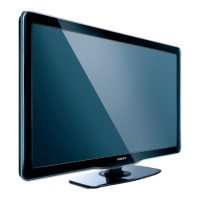Do you have a question about the Philips 32PFL5604H/12 and is the answer not in the manual?
Provides technical details and connection information for the television.
Outlines essential safety regulations to follow during TV repair.
Highlights important warnings regarding ESD, high voltage, and tool usage during repairs.
Step-by-step instructions for removing the rear cover, speakers, boards, and LCD panel.
Explains the different service modes (SDM, SAM, CSM) and the ComPair interface.
Details the purpose and activation of the Service Default Mode (SDM).
Explains how to activate and use the Service Alignment Mode (SAM) for alignments and settings.
Details how error codes are logged, displayed, and managed in the chassis.
Explains methods to read the error buffer via SAM, blinking LED, or ComPair.
Describes how the front LED blinks to indicate Layer 1 and Layer 2 errors.
Covers software and hardware protections, including supply errors and start-up protections.
Offers practical advice for troubleshooting and repairing common issues like Ambilight and DC/DC converters.
Provides instructions and flowcharts for replacing the SSB and performing necessary software updates.
Details the process of upgrading the TV's main and stand-by software via USB.
Specifies the electrical conditions required for performing all adjustments and measurements.
Details software alignments for Tuner AGC and White Point, including test signal requirements.
Explains how the microprocessor uses option codes to communicate with ICs for diagnosis.
Highlights the importance of resetting the NVM on a repaired SSB and setting service type.
Describes the power supplies used in the TV543 Forward Integration platform.
Discusses input power, control mechanisms, and provides a block diagram of DC-DC converters.
Describes the PNX8543 as the main audio/video processor, detailing its functions and architecture.
Provides technical details and connection information for the television.
Outlines essential safety regulations to follow during TV repair.
Highlights important warnings regarding ESD, high voltage, and tool usage during repairs.
Step-by-step instructions for removing the rear cover, speakers, boards, and LCD panel.
Explains the different service modes (SDM, SAM, CSM) and the ComPair interface.
Details the purpose and activation of the Service Default Mode (SDM).
Explains how to activate and use the Service Alignment Mode (SAM) for alignments and settings.
Details how error codes are logged, displayed, and managed in the chassis.
Explains methods to read the error buffer via SAM, blinking LED, or ComPair.
Describes how the front LED blinks to indicate Layer 1 and Layer 2 errors.
Covers software and hardware protections, including supply errors and start-up protections.
Offers practical advice for troubleshooting and repairing common issues like Ambilight and DC/DC converters.
Provides instructions and flowcharts for replacing the SSB and performing necessary software updates.
Details the process of upgrading the TV's main and stand-by software via USB.
Specifies the electrical conditions required for performing all adjustments and measurements.
Details software alignments for Tuner AGC and White Point, including test signal requirements.
Explains how the microprocessor uses option codes to communicate with ICs for diagnosis.
Highlights the importance of resetting the NVM on a repaired SSB and setting service type.
Describes the power supplies used in the TV543 Forward Integration platform.
Discusses input power, control mechanisms, and provides a block diagram of DC-DC converters.
Describes the PNX8543 as the main audio/video processor, detailing its functions and architecture.
| Screen Size | 32 inches |
|---|---|
| Display diagonal | 81 cm |
| Resolution | 1366 x 768 pixels |
| Display resolution | 1366 x 768 pixels |
| Display Technology | LCD |
| Screen shape | Flat |
| Aspect ratio | 16:9 |
| Contrast ratio (typical) | 1000:1 |
| Response time | 8 ms |
| Viewing angle, horizontal | 176 degrees |
| Viewing angle, vertical | 176 degrees |
| Display brightness | 300 cd/m² |
| Comb filter | 3D comb filter |
| Number of speakers | 2 |
| HDMI Ports | 3 |
| Component video (YPbPr/YCbCr) in | 1 |
| SCART ports quantity | 1 |
| S-Video inputs quantity | 1 |
| PC in (D-Sub) | 1 |
| Common interface (CI) | Yes |
| Common interface Plus (CI+) | Yes |
| USB Ports | 1 |
| HD Type | HD Ready |
| Refresh Rate | 50 Hz |
| Smart TV | No |
| Built-in Wi-Fi | No |
| Energy Efficiency Class | A |
| Digital signal format system | DVB-T |












